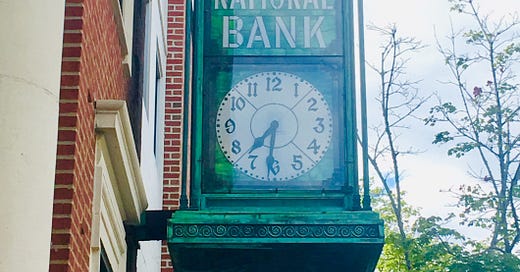Above the hustle of Bar Harbor’s Main Street is a green chime clock that once cost $3,350, but now is considered priceless to many.
It wasn’t always like this.
The clock at First National Bank of Bar Harbor almost didn’t survive past 1969. That was when a crew from A.B. & J.R. Hodgkins hauled a crane up Main Street and prepared to take down the chime clock that the bank had originally purchased in 1929.
The workers had even erected staging to take down the giant clock safely. The chimes were already taken down. The giant clock’s removal looked like a done deal.
One Bar Harbor woman refused to let that happen.
That woman was Elizabeth Owens.
According to Kip Soule’s history of the bank that he wrote in 1992, “Mrs. Owens came up the street and inquired of the workmen what they were doing. Upon being advised that they were going to remove the clock, Mrs. Owens stormed into the bank ….”
She informed the bank’s president that if he removed the clock, she’d remove her money. She had a lot of money. She also said that her friends would do the same. Her friends also had a lot of money.
“Needless to say, Mrs. Owens made her point and the clock was not removed. The Board decided the clock would be allowed to remain as long as it continued to operate,” Soule writes.
The Board was a little tricky about this though. Instead of servicing the clock twice a year? It wasn’t serviced at all. To be fair, the company that had traditionally taken care of the clock had gone out of business.
Despite all this, the clock kept ticking.
Current Bank President and CEO Tony McKim was determined to keep it that way, servicing and restoring the historic timepiece.
As Grif Fenton said on McKim’s Facebook post about the clock, “After all the changes in Bar Harbor there are two iconic structure types that have made the town so attractive!
The fountains in the two parks and the clocks on Main Street. Thank you for preserving this beautiful clock for future generations. We love it!”
The thing is that stand-alone watches and clocks are bits of our history. That history fades as technology moves forward. We often hurry to cast aside the old to make way for new gadgets, but that choice? It isn’t always the right one.
On McKim’s post, he called the clock a grand piece of Bar Harbor Americana.
There is something both beautiful and familiar about a giant clock on Main Street, a grandfather clock in a hall; there is something that is romantic and nostalgic about a white Hello Kitty alarm clock placed by a kid’s bed and then found again in a bin in the attic when its original owner has their own child. There is something irresistible about those hands on a dial circling around and around again on a clock face, perfectly with a constant speed keeping track of the minutes, the moments, the seconds that go by.
A clock can reassure you even if you are in the most rotten mental space, trying to figure out your life and your purpose as you snake around tourists on a crowded summer sidewalk. The clock is a sentinel as you wander Bar Harbor streets as smells of grease pits and suntan lotion and cruise ship perfumes blend into something that is both beautiful and nauseating all at once.
A clock can’t solve your problems, but it can tell you where you are in a moment of your day. It can be something you look up to, recognize, and remember.
There’s a great simplicity of purpose in a clock or a watch. All it is meant to do is tell you the time. It doesn’t answer questions, spy on you, collect your data. It can’t give advice. It just is.
And sometimes that clock is beautiful, a landmark that becomes part of a town’s history. That’s the case with the stained-glass Tiffany-dome clock that looms above Main Street in Bar Harbor.
Thanks to a more clock-friendly bank board in the 1980s through today, the clock is still attached to the First National Bank, which was originally established in the mid to late 1800s. The vintage clock has been maintained and lovingly restored by the bank, a gorgeous testament to history, our town and its institutions.
Once called a ‘monstrosity,’ and believed to no longer be useful because it didn’t tell the weather and wasn’t the latest technology around in the late 1960s, the clock at the First National Bank of Bar Harbor still chimes on the quarter, full, and half hours. At night, its light shines down on tourists and locals alike. It brings us all together despite our differences, our incomes, our homes, our genders, political affiliations and abilities. The passing of time continues, ticks on, and we are all bathed in the knowledge and its light.





